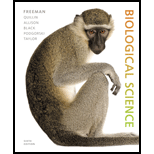
Concept explainers
The genes for the trails that Mendel worked with are either all located on different chromosomes or behave as if they were. How did this help Mendel recognize the principle of independent assortment?
a. Otherwise, his dihybrid crosses would not have produced a 9:3:3:1 ratio of F2
b. The occurrence of individuals with unexpected phenotypes led him to the discovery of recombination.
c. It led him to the realization that the behavior of chromosomes during meiosis explained his results.
d. It meant that the alleles involved were either dominant or recessive, which gave 3:1 ratios in the F1 generation.
Introduction:
The principle of independent assortment states that the genes coding for different traits is passed on to the next generation independent of each other. This law of independence assortment holds true only in the case where the two pairs of characters are coded by genes that are present on two different chromosomes.
Answer to Problem 1TYK
Correct answer:
In case the genes for the trait would have been on the same chromosome, the ratio in the F2 generation would have been other than 9:3:3:1.
Explanation of Solution
Explanation/Justification for the correct answer:
Option (a) is given as the pairs are independently assorted the progeny can have different phenotypes. In case the genes are present on the same chromosome, they might show some degree of linkage. Furthermore, the presence of the genes on the same chromosome would have resulted in crossing over and alteration of the ratio of the F2 generation. Hence, Option (a) is correct.
Explanation for incorrect answers:
Option (b) is given as the discovery of the recombination as a result of the occurrence of the individuals with unexpected phenotypes. However, the process of recombination was discovered by the experiments conducted by Thomas Hunt Morgan and his colleagues on Drosophila. So, this is the wrong answer.
Option (c) is given as the results obtained during meiosis were due to the behavior of chromosomes. Mendel believed that the determinants of heredity never show blending and never gets modified. So, this is the wrong answer.
Option (d) is given as the 3:1 ratio in the F1 generation signifying that the alleles involved were either dominant or recessive. The principle of the independent assortment was introduced because of the dihybrid cross. So, this is the wrong answer.
Hence, options (b), (c), and (d) are incorrect.
Thus, the location of the chromosomes for the genes with which Mendel worked resulted in the unexpected phenotypes that helped him in recognizing the principle of independent assortment.
Want to see more full solutions like this?
Chapter 14 Solutions
Biological Science (6th Edition)
- Can you described the image? Can you explain the question as well their answer and how to get to an answer to an problem like this?arrow_forwardglg 112 mid unit assignment Identifying melting processesarrow_forwardGive only the mode of inheritance consistent with all three pedigrees and only two reasons that support this, nothing more, (it shouldn't take too long)arrow_forward
- Oarrow_forwardDescribe the principle of homeostasis.arrow_forwardExplain how the hormones of the glands listed below travel around the body to target organs and tissues : Pituitary gland Hypothalamus Thyroid Parathyroid Adrenal Pineal Pancreas(islets of langerhans) Gonads (testes and ovaries) Placentaarrow_forward
- What are the functions of the hormones produced in the glands listed below: Pituitary gland Hypothalamus Thyroid Parathyroid Adrenal Pineal Pancreas(islets of langerhans) Gonads (testes and ovaries) Placentaarrow_forwardDescribe the hormones produced in the glands listed below: Pituitary gland Hypothalamus Thyroid Parathyroid Adrenal Pineal Pancreas(islets of langerhans) Gonads (testes and ovaries) Placentaarrow_forwardPlease help me calculate drug dosage from the following information: Patient weight: 35 pounds, so 15.9 kilograms (got this by dividing 35 pounds by 2.2 kilograms) Drug dose: 0.05mg/kg Drug concentration: 2mg/mLarrow_forward
- A 25-year-old woman presents to the emergency department with a 2-day history of fever, chills, severe headache, and confusion. She recently returned from a trip to sub-Saharan Africa, where she did not take malaria prophylaxis. On examination, she is febrile (39.8°C/103.6°F) and hypotensive. Laboratory studies reveal hemoglobin of 8.0 g/dL, platelet count of 50,000/μL, and evidence of hemoglobinuria. A peripheral blood smear shows ring forms and banana-shaped gametocytes. Which of the following Plasmodium species is most likely responsible for her severe symptoms? A. Plasmodium vivax B. Plasmodium ovale C. Plasmodium malariae D. Plasmodium falciparumarrow_forwardStandard Concentration (caffeine) mg/L Absorbance Reading 10 0.322 20 0.697 40 1.535 60 2.520 80 3.100arrow_forwardPlease draw in the missing answer, thank youarrow_forward
 Human Heredity: Principles and Issues (MindTap Co...BiologyISBN:9781305251052Author:Michael CummingsPublisher:Cengage Learning
Human Heredity: Principles and Issues (MindTap Co...BiologyISBN:9781305251052Author:Michael CummingsPublisher:Cengage Learning Biology: The Dynamic Science (MindTap Course List)BiologyISBN:9781305389892Author:Peter J. Russell, Paul E. Hertz, Beverly McMillanPublisher:Cengage Learning
Biology: The Dynamic Science (MindTap Course List)BiologyISBN:9781305389892Author:Peter J. Russell, Paul E. Hertz, Beverly McMillanPublisher:Cengage Learning Biology Today and Tomorrow without Physiology (Mi...BiologyISBN:9781305117396Author:Cecie Starr, Christine Evers, Lisa StarrPublisher:Cengage Learning
Biology Today and Tomorrow without Physiology (Mi...BiologyISBN:9781305117396Author:Cecie Starr, Christine Evers, Lisa StarrPublisher:Cengage Learning Biology 2eBiologyISBN:9781947172517Author:Matthew Douglas, Jung Choi, Mary Ann ClarkPublisher:OpenStax
Biology 2eBiologyISBN:9781947172517Author:Matthew Douglas, Jung Choi, Mary Ann ClarkPublisher:OpenStax Concepts of BiologyBiologyISBN:9781938168116Author:Samantha Fowler, Rebecca Roush, James WisePublisher:OpenStax College
Concepts of BiologyBiologyISBN:9781938168116Author:Samantha Fowler, Rebecca Roush, James WisePublisher:OpenStax College Human Biology (MindTap Course List)BiologyISBN:9781305112100Author:Cecie Starr, Beverly McMillanPublisher:Cengage Learning
Human Biology (MindTap Course List)BiologyISBN:9781305112100Author:Cecie Starr, Beverly McMillanPublisher:Cengage Learning





